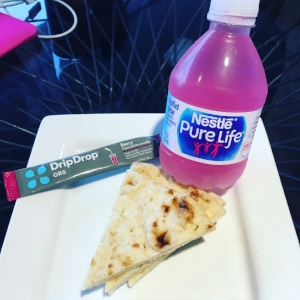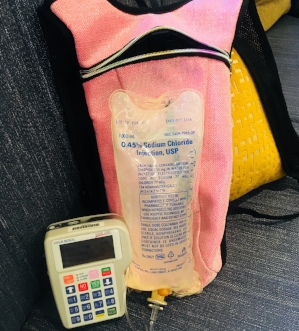IBD | Information | Ostomy

I’m sitting in a lounge at London’s Heathrow airport after a marathon week of planes, trains, and miles of walking. Necessary goals for this couple hours include hooking up a new bag of IV fluids and mixing up another batch of DripDrop ORS- you know, normal stuff. I’ve spent this week traveling around England with a brief cruise over to France and back. It’s been an adventure and a half, and I’m proud to say that my extensive packing and planning let me have a great time! Including DripDrop packets in my bag of tricks for this trek helped me to stay vigilant about one of the key fundamentals for a girl with Crohn’s- hydration.

Many people with IBD, especially those who’ve had multiple surgeries and/or have ostomies, will tell you that one of the most important and challenging aspects of the disease is staying hydrated. I have a permanent ileostomy and my remaining gut is short enough that I’m now dependent on IV fluids to supplement my oral intake. Infusing two bags of fluids each day can be a drag and always makes being out and about a bit more interesting (it’s pretty easy to catch my line on a door handle or the arm of a chair), but wearing an IV backpack is better than dealing with the headaches, dizziness, and low blood pressure I’d have without it.
When hydrating orally, I’m careful to avoid sugary drinks that will increase my output. Even regular water often goes straight through me and quickly fills up my ostomy pouch. When I was at the Cleveland Clinic, I learned the importance of drinking oral rehydration solution (ORS) instead. The sodium-glucose cotransport system in the intestinal mucosa allows the movement of salt, sugar, and water in and out of the gut. Drinking solutions with specific ratios of sugar and salt helps optimizes the amount of water absorbed by the gut and to maintain adequate electrolyte levels. At home, I make ORS with two tablespoons of sugar and ½ teaspoon of salt in a liter of Powerade Zero.
Looking forward to my trip, I obviously needed a more practical option while on the go. There are many products available that are advertised as solutions to dehydration, but most sports drinks contain too much sugar and very little salt, which can actually make dehydration worse. Others, like packets of electrolyte gels, are designed for the needs of endurance athletes losing water and electrolytes primarily through sweat and aren’t ideal for the needs of IBD patients. I’ve therefore been skeptical to use anything besides the homemade ORS that I was taught to make by the gut rehab specialists I’ve visited, but the needs of my upcoming travel meant I needed to try.
I’ve heard some of the ladies in the Girls with Guts Private Facebook Forum talk about DripDrop in the past, and seeing as they helped sponsor the 2018 GWG Celebration in Chicago and had just donated a bunch to our Butt Baskets program, I decided to give it a shot. With some quick reading on their site, I learned that DripDrop is actual ORS (unlike the other products I’ve mentioned), and as such, is based on the formula used globally by the World Health Organization (WHO) to treat dehydration secondary to diarrhea. Additionally, unlike my homemade ORS, which has only sodium, DripDrop also contains potassium and magnesium. Inadequate levels of any of these three electrolytes is very common in IBD patients with frequent bowel movements and are often given via IV in emergency room or inpatient hospital settings. If you’ve read any of my IBD Academy posts, you know that I’m a stickler for science, so this information encouraged me that I was headed down the right path by giving DripDrop a try. I encourage you to read up on ORS here: https://dripdrop.com/pages/science.
The lounge where we were waiting in Atlanta before our first flight had mini 8 ounce bottles of water, which was perfect, because a 10g packet of DripDrop is meant for that volume. I mixed up my first batch then and had it with some pita bread in an attempt at a virtuous, ostomy-compatible pre-flight snack. It didn’t taste salty and I didn’t have to force it down, unlike many other unpleasant liquids I’ve encountered along my 15 years with Crohn’s. I liked the berry flavor and was curious to see how the others would compare- I’ve done enough scope/imaging preps that artificial fruit flavors are now sometimes very unpalatable.

As my trip progressed, I would mix some up with water at breakfast and do a double batch in a bottle to drink throughout the day. It took a little work to get the ratios of water and DripDrop right, as water glasses aren’t a standard size and bottle of water in England/France are measured in mL. I was glad to see that it mixes up quickly enough that it’s not completely awkward to do in a restaurant and just looks like a glass of (rather brightly colored) juice. I learned that it doesn’t taste great if it’s too watered down and is better cold than once it warms up, especially in the watermelon and lemon flavors. I still like the berry the best, probably because it tastes similar to what I’m used to drinking at home.
As far as maintaining hydration, I can tell you that I did more physical activity this past week than I have in probably the last three months. My legs were sore from all the walking, but even though I was sweating a lot, I wasn’t having the muscle cramping that I can get when my electrolytes are really depleted. What I was eating still had a huge impact on how much of the fluid I was losing into the ostomy, but I wasn’t losing it all like I would if I was drinking regular juice or lemonade. Overall, a thumbs up for DripDrop! I’ll definitely be adding an emergency stash to my purse and packing extra when I’m doing (more) traveling for weddings over the next couple months.

Kristen Weiss Sanders is a proud and third generation girl with guts diagnosed with IBD in 2004. She is passionate about patient education and encourages those with chronic illness to be a knowledgable part of their healthcare team. Kristen credits the constant example and support of the strong women in her family for her determination to thrive with Crohn’s disease and use her IBD journey to empower others. She lives in Dalton, GA with her husband, Wesley, and their three tanks of tropical fish.
